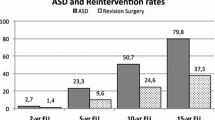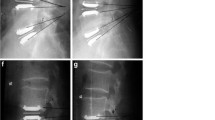Abstract
Purpose
To evaluate the impact of pre-existing disc degeneration and its extent on future adjacent segment degeneration (ASDeg) after lumbar posterolateral fusion (PLF).
Methods
A total of 102 patients who had undergone PLF for degenerative lumbar diseases from January 2006 to December 2008 were retrospectively reviewed by using radiography and clinical evaluation. The University of California at Los Angeles (UCLA) grading scale was used to evaluate the extent of disc degeneration. The Visual Analog Scale, Oswestry Disability Index, and SF-36 questionnaire were used to evaluate clinical outcomes.
Results
The overall prevalence of radiological ASDeg was 25.5 %, and the prevalence of ASDeg for the cranial and caudal levels was 19.6 and 15.1 %, respectively. The prevalence of ASDeg in one-, two-, and three-level fusion was 15.8, 26.3, and 50 %, respectively (p = 0.008). For the cranial level, the preoperative UCLA grade A, B, and C groups had prevalence values for ASDeg of 13.5, 28.6, and 42.9 %, respectively (p = 0.026). A higher prevalence of ASDeg was found in cranial discs with pre-existing degeneration than in the group without pre-existing degeneration (p = 0.012). The group without pre-existing degeneration showed better outcomes. For the caudal level, there was no significant difference in ASDeg prevalence. At final follow-up, the group without pre-existing disc degeneration showed better outcomes than the group with pre-existing disc degeneration.
Conclusions
Adjacent segment discs with pre-existing degeneration had a higher likelihood of ASDeg progression compared with normal discs, especially for those classified as UCLA grade C.

Similar content being viewed by others
References
Kumar MN, Baklanov A, Chopin D (2001) Correlation between sagittal plane changes and adjacent segment degeneration following lumbar spine fusion. Eur Spine J 10:314–319
Etebar S, Cahill DW (1999) Risk factors for adjacent-segment failure following lumbar fixation with rigid instrumentation for degenerative instability. J Neurosurg 90:163–169
Nagata H, Schendel MJ, Transfeldt EE, Lewis JL (1993) The effects of immobilization of long segments of the spine on the adjacent and distal facet force and lumbosacral motion. Spine 18:2471–2479
Wiltse LL, Radecki SE, Biel HM, DiMartino PP, Oas RA, Farjalla G, Ravessoud FA, Wohletz C (1999) Comparative study of the incidence and severity of degenerative change in the transition zones after instrumented versus noninstrumented fusions of the lumbar spine. J Spinal Disord 12:27–33
Bastian L, Lange U, Knop C, Tusch G, Blauth M (2001) Evaluation of the mobility of adjacent segments after posterior thoracolumbar fixation: a biomechanical study. Eur Spine J 10:295–300
Chen CS, Cheng CK, Liu CL (2002) A biomechanical comparison of posterolateral fusion and posterior fusion in the lumbar spine. J Spinal Disord Tech 15:53–63
Rao RD, David KS, Wang M (2005) Biomechanical changes at adjacent segments following anterior lumbar interbody fusion using tapered cages. Spine 30:2772–2776
Wai EK, Santos ERG, Morcom RA, Fraser RD (2006) Magnetic resonance imaging 20 years after anterior lumbar interbody fusion. Spine 31:1952–1956
Ghiselli G, Wang JC, Hsu WK, Dawson EG (2003) L5–S1 segment survivorship and clinical outcome analysis after L4–L5 isolated fusion. Spine 28:1275–1280
Liao JC, Chen WJ, Chen LH, Niu CC (2009) Outcome of the L5–S1 segment after posterior instrumented spinal surgery in degenerative lumbar diseases. Chang Gung Med J 32:81–88
Mimura M, Panjabi MM, Oxland TR, Crisco JJ, Yamamoto I, Vasavada A (1994) Disc degeneration affects the multidirectional flexibility of the lumbar spine. Spine 19:1371–1380
Macdermid JC, Walton DM, Avery S, Blanchard A, Etruw E, McAlpine C, Goldsmith CH (2009) Measurement properties of the neck disability index: a systematic review. J Orthop Sports Phys Ther 39:400–417
Ware JE Jr (2000) SF-36 health survey update. Spine 25:3130–3139
Ghiselli G, Wang JC, Bhatia NN, Hsu WK, Dawson EG (2004) Adjacent segment degeneration in the lumbar spine. J Bone Joint Surg Am 86:1497–1503
Fischgrund JS, Mackay M, Herkowitz HN, Brower R, Montgomery DM, Kurz LT (1997) 1997 Volvo Award winner in clinical studies. Degenerative lumbar spondylolisthesis with spinal stenosis: a prospective, randomized study comparing decompressive laminectomy and arthrodesis with and without spinal instrumentation. Spine 22:2807–2812
Simmons ED Jr, Simmons EH (1992) Spinal stenosis with scoliosis. Spine 17:S117–S120
Park P, Garton HJ, Gala VC, Hoff JT, McGillicuddy JE (2004) Adjacent segment disease after lumbar or lumbosacral fusion: review of the literature. Spine 29:1938–1944
Miyakoshi N, Abe E, Shimada Y, Okuyama K, Suzuki T, Sato K (2000) Outcome of one-level posterior lumbar interbody fusion for spondylolisthesis and postoperative intervertebral disc degeneration adjacent to the fusion. Spine 25:1837–1842
Kumar MN, Jacquot F, Hall H (2001) Long-term follow-up of functional outcomes and radiographic changes at adjacent levels following lumbar spine fusion for degenerative disc disease. Eur Spine J 10:309–313
Radcliff K, Curry P, Hilibrand A, Kepler C, Lurie J, Zhao W, Albert TJ, Weinstein J (2013) Risk for adjacent segment and same segment reoperation after surgery for lumbar stenosis: a subgroup analysis of the Spine Patient Outcomes Research Trial (SPORT). Spine 38:531–539
Kornblum MB, Fischgrund JS, Herkowitz HN, Abraham DA, Berkower DL, Ditkoff JS (2004) Degenerative lumbar spondylolisthesis with spinal stenosis: a prospective long-term study comparing fusion and pseudarthrosis. Spine 29:726–733
Aiki H, Ohwada O, Kobayashi H, Hayakawa M, Kawaguchi S, Takebayashi T, Yamashita T (2005) Adjacent segment stenosis after lumbar fusion requiring second operation. J Orthop Sci 10:490–495
Gillet P (2003) The fate of the adjacent motion segments after lumbar fusion. J Spinal Disord Tech 16:338–345
Umehara S, Zindrick MR, Patwardhan AG, Havey RM, Vrbos LA, Knight GW, Miyano S, Kirincic M, Kaneda K, Lorenz MA (2000) The biomechanical effect of postoperative hypolordosis in instrumented lumbar fusion on instrumented and adjacent spinal segments. Spine 25:1617–1624
Chen CS, Feng CK, Cheng CK, Tzeng MJ, Liu CL, Chen WJ (2005) Biomechanical analysis of the disc adjacent to posterolateral fusion with laminectomy in lumbar spine. J Spinal Disord Tech 18:58–65
Conflict of interest
No benefits in any form have been received or will be received related directly or indirectly to the subject of this article. The manuscript submitted does not contain information about medical device(s)/drug(s). No funds were received in support of this work.
Author information
Authors and Affiliations
Corresponding author
Rights and permissions
About this article
Cite this article
Li, C., He, Q., Tang, Y. et al. The fate of adjacent segments with pre-existing degeneration after lumbar posterolateral fusion: the influence of degenerative grading. Eur Spine J 24, 2468–2473 (2015). https://doi.org/10.1007/s00586-015-3921-2
Received:
Revised:
Accepted:
Published:
Issue Date:
DOI: https://doi.org/10.1007/s00586-015-3921-2




